

Saxon Documentation. The open-source Saxon-HE product does not require any license key.

For Saxon-PE and Saxon-EE, however, you need to obtain a license key from Saxonica. You can order a free license key for a 30-day evaluation, or purchase an unrestricted license key, from the Saxonica web site. Since Saxon 9.2, newly issued license keys are compatible across the Java and .NET platforms. The older .NET license keys (named saxon-license.xml) are no longer accepted. The license key will arrive in the form of a file named saxon-license.lic attached to an email message. The location specified using the configuration property FeatureKeys.LICENSE_FILE_LOCATION, as described below. On the Java platform it is generally simplest to copy the file to the directory in which saxon9ee.jar is installed.
If you acquire Saxon-PE or Saxon-EE as a component of an application with which it has been integrated, the application may activate the software automatically using an OEM license key. Using Stylesheets. Using Stylesheets This page describes how to use SAXON XSLT Stylesheets, either from the command line, or from the Java API, or as an Applet in the browser.
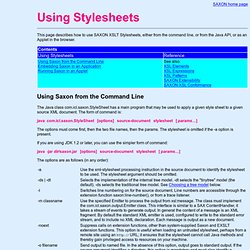
Using Saxon from the Command Line. XSD - ScoLOMFR. Consultation des vocabulaires - ScoLOMFR. La version 2.0 du profil d'application ScoLOMFR est disponible à partir du 25/02/2016.
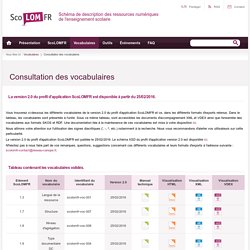
Vous trouverez ci-dessous les différents vocabulaires de la version 2.0 du profil d'application ScoLOMFR et ce, dans les différents formats d'exports retenus. Dans le tableau, les vocabulaires sont présentés à l'unité. Sous ce même tableau, sont accessibles les documents d'accompagnement XML et VDEX ainsi que l'ensemble des vocabulaires aux formats SKOS et RDF. Une documentation liée à la maintenance de ces vocabulaires est mise à votre disposition ici. Nous attirons votre attention sur l'utilisation des signes diacritiques (', -, ^, etc.) notamment à la recherche. La version 2.0 du profil d'application ScoLOMFR est publiée le 25/02/2016. N'hésitez pas à nous faire part de vos remarques, questions, suggestions concernant ces différents vocabulaires et leurs formats d'exports à l'adresse suivante : scolomfr-contact@reseau-canope.fr.
Saxonica Developer Community. The SAXON XSLT and XQuery Processor. SAXON Documentation. Validation from the Command Line. XML Path Language (XPath) 2.0 (Second Edition) XQuery 1.0 and XPath 2.0 Functions and Operators (Second Edition) See [Working With Timezones] for a disquisition on working with date and time values with and without timezones. 10.1 Duration, Date and Time Types The operators described in this section are defined on the following date and time types: xs:dateTimexs:datexs:timexs:gYearMonthxs:gYearxs:gMonthDayxs:gMonthxs:gDay Note that only equality is defined on xs:gYearMonth, xs:gYear, xs:gMonthDay, xs:gMonth and xs:gDay values.

In addition, operators are defined on: ODF Application: XLST Transformation. Download version of 28 Mar 2006 This is an alpha version of a stylesheet that converts the content.xml of an OpenDocument text file to XHTML.
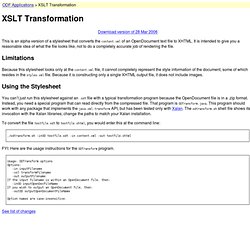
It is intended to give you a reasonable idea of what the file looks like, not to do a completely accurate job of rendering the file. Limitations Because this stylesheet looks only at the content.xml file, it cannot completely represent the style information of the document, some of which resides in the styles.xml file. Because it is constructing only a single XHTML output file, it does not include images. Using the Stylesheet. L'essentiel de XML. NISO Standard DTD and CSS files. Skip to Main Content Search form Login | Contact Us Creating the best way to read and publish DAISY/NISO Standard DTD and CSS files List of most current DTDs List of CSS files.
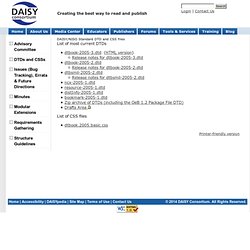
C QA - Recommended list of Doctype declarations you can use in your Web document. Warning The list is informative and does not try to be exhaustive (there are many other proper declarations you could use), but it has most of the declarations commonly used on the Web at the moment.

Recommended Doctype Declarations to use in your Web document. When authoring document is HTML or XHTML, it is important to Add a Doctype declaration. The doctype declaration must be exact (both in spelling and in case) to have the desired effect, which makes it sometimes difficult. To ease the work, below is a list of recommended doctype declarations that you can use in your Web documents. UTS #18: Unicode Regular Expressions. Unicode Technical Standard #18 Summary This document describes guidelines for how to adapt regular expression engines to use Unicode.
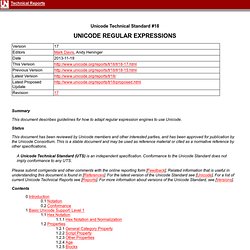
Status This document has been reviewed by Unicode members and other interested parties, and has been approved for publication by the Unicode Consortium. This is a stable document and may be used as reference material or cited as a normative reference by other specifications. #regular-expressions. #regex-syntax. See [Working With Timezones] for a disquisition on working with date and time values with and without timezones. 10.1 Duration, Date and Time Types The operators described in this section are defined on the following date and time types:
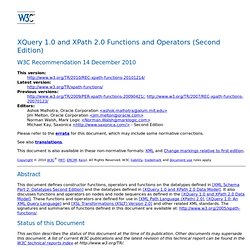
XSLT 2.0.